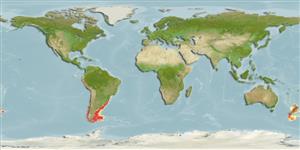Common names from other countries
Classification / Names / Names
Populärnamn | synonymer | Catalog of Fishes (gen., sp.) | ITIS | CoL | WoRMS
Environment: milieu / climate zone / depth range / distribution range
Ekologi
Djupbottenlevande. Tropical; 0°N - 90°S, 180°W - 180°E
Southeast Pacific and Southwest Atlantic: South America. Tropical to temperate.
Length at first maturity / Size / Vikt / Age
Maturity: Lm ? range ? - ? cm Max length : 260 cm TL hane/ej könsbestämd; (Ref. 1394); 220 cm TL (female); publicerad maxvikt: 350.0 kg (Ref. 1394); publicerad maxvikt: 350.0 kg
Found over the continental shelf and slope. Occurs in deep waters, and also venture into freshwaters in rivers and around glaciers. Feeds on many species of benthic and pelagic fishes, and invertebrates (i.e. lobster, krill, squid, octopus, and jellyfish), and occasionally penguins and young South American seals) (Ref. 1394). Preyed upon by a sevengill shark (Ref. 8910). Found over the continental shelf and slope. Occurs in deep waters, and also venture into freshwaters in rivers and around glaciers. Feeds on many species of benthic and pelagic fishes, and invertebrates (i.e. lobster, krill, squid, octopus, and jellyfish), and occasionally penguins and young South American seals) (Ref. 1394).
Jefferson, T.A., S. Leatherwood and M.A. Webber. 1993. (Ref. 1394)
IUCN Red List Status (Ref. 130435)
CITES status (Ref. 108899)
Not Evaluated
Human uses
Fiskeri: kommersiell
FAO - fiskeri: landings, species profile | FishSource | Sea Around Us
Verktyg
Internet-källor
Estimates based on models
Preferred temperature
(Ref.
115969): 6.3 - 15.6, mean 9.9 (based on 922 cells).
Resiliens
Hög, lägsta populationsfördubblingstid mindre än 15 månader (K=0.31-0.31).
Vulnerability
Moderate to high vulnerability (51 of 100).
Price category
Unknown.
